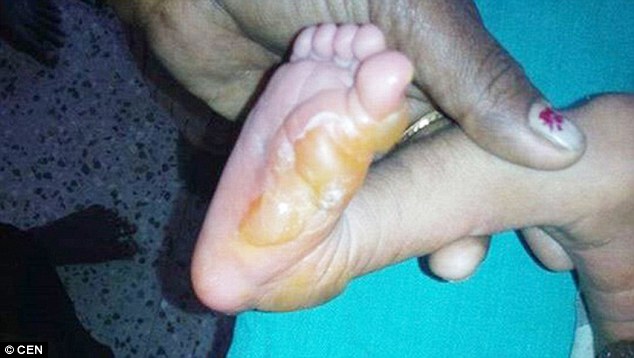In the first incident in 2013 the couple's first baby, Rahul, ended up in the intensive care ward at a hospital in south-eastern India's Viluppuram District, in the Tamil Nadu State, after neighbours had heard him screaming, and rushed into the house from outside to discover the child on fire in his cot.
His mother, who was working in the fields, took him to hospital and since then he has caught fire another three times, she claimed.

Does spontaneous human combustion really exist?
One of the first serious accounts of it appeared in the august journal Philosophical Transactions Of The Royal Society in 1745, which recorded how a 62-year-old Italian countess had gone to bed one night feeling 'dull and heavy'. The next morning, all that was found in her bedroom was a pile of ash and her legs.
Many other cases followed, and by 1806, one scientist thought he had the answer. In An Essay On The Combustion Of Humans, Pierre Lair suggested that the problem was the demon drink, and he subtitled his article, Products Of The Abuse Of Spirituous Liquors.
The explanation that alcohol was to blame quickly caught on, especially among moralists who were against the hard stuff. In 1832, a popular Victorian magazine claimed all those who suddenly burst into flames were 'habitually drunken'.
The notion was so widespread that when Charles Dickens included an episode of spontaneous human combustion in his 1852 novel Bleak House, the victim — the villainous Mr Krook — was said to be 'continual in liquor'.
British research biologist Brian J. Ford argued in two articles, one of which appeared in the New Scientist, that spontaneous human combustion may be caused by a chemical called acetone that is produced naturally in the body, the chemical often used as a solvent in nail-varnish removers.
In healthy humans, acetone is normally disposed of through urine, but when people suffer from certain illnesses, acetone levels can build up in the body, and can even be smelled on the breath.
On the website Mumsnet, one poster wrote that her young daughter had 'acetone breath', and that 'apparently children have higher than normal acetone levels'.
Professor Ford has noted that many of the people who have combusted spontaneously were unwell at the time, and as a result, may have developed a condition called ketosis, in which acetone in the body increases.
Ketosis can have a range of causes, including alcoholism, diabetes, a high-fat diet, and even, in babies, teething.
Furthermore, acetone infuses itself well into human fat. And it is also extremely flammable.
Unable to find a human volunteer to test his theory that a build-up of acetone causes spontaneous human combustion, Professor Ford made a model from pieces of pork - the animal flesh that most closely approximates ours.
The 'pork puppet' was marinated in acetone, dressed in clothes, and placed in a chair. Professor Ford then held up a gas lighter, and the result was dramatic. The 'body' burst into a fireball, and in under an hour, it had been completely consumed by flames.
In fact, the acetone was so volatile, that even just a static spark from synthetic fabrics could have caused the conflagration.
All that was left - as is so often the case with spontaneous human combustion - were the legs, which Professor Ford suggests remain unburned because there is not enough fat in that part of the body to store the flammable acetone.

The child, not named, was rushed into the Government Kilpauk Hospital by his mother, Rajeshwari Karnan, who claimed that her son's feet had spontaneously combusted while she was in the bath and that she had managed to beat out the flames before rushing him to hospital.
Medics said that the boy had about 10 per cent burn damage to his feet in an incident that happened when he was 10-days-old. Rajeswari said she had heard him screaming and found his feet on fire in a repeat incident that mirrored the 'spontaneous combustion' of his older brother.
After over a month in neonatal intensive care unit, the burns have healed and the baby is now fit for discharge, according to hospital dean Narayana Babu. However, social workers are now looking at the issue of whether it is safe to release the child back to his parents.
He said: 'All tests reveal he is completely normal, and the parents too, went through psychiatric counselling and were found to be normal.'
However medics are still reluctant to hand the child over for fears that one of the parents, they suspect the mother, is suffering from the Munchausen by proxy syndrome in which a parent seeks to harm their child in order to get attention.
Child psychiatrist Shiva Prakash Srinivasan told local media: 'This need for attention is fulfilled by bringing the child into a hospital with a medical condition, and getting attention, and in this case with worldwide headlines there was certainly a lot of attention.'
Spokesperson for Tulir - the Centre for the Prevention and Healing of Child Sexual Abuse - Vidya Reddy said: 'From all that I have read, it definitely seems like the mother has this syndrome. It is vital that she be assessed appropriately and helped as soon as possible. Also, the child protection systems in the state must intervene in this case immediately.'
Rajeshwari, 25, said the suggestion that she had caused the fire that damaged her two sons was ludicrous.
She said that she and her husband Karnan Perumal, 28, had been the only ones around each time the incident happened but it was ridiculous to suggest either of them were to blame.
At the time speculation had circulated around the world that baby Rahul was a victim of spontaneous human combustion. The couple also have an older daughter, Narmatha, who has not yet been a victim of the condition.
Medics who suspect the mother is to blame for the incidents pointed out that the phenomenon has never been proven to exist, given the large amount of water the average human body contains.
Crematoriums use at least 30 cubic metres of gas, along with 600 cubic metres of pre-heated air, to incinerate a corpse.
However British research biologist Brian J. Ford argued in two articles, one of which appeared in the New Scientist, that spontaneous human combustion may be caused by a chemical called acetone that is produced naturally in the body, the chemical often used as a solvent in nail-varnish removers.
In healthy humans, acetone is normally disposed of through urine, but when people suffer from certain illnesses, acetone levels can build up in the body, and can even be smelled on the breath.
On the website Mumsnet, one poster wrote that her young daughter had 'acetone breath', and that 'apparently children have higher than normal acetone levels'.
Professor Ford has noted that many of the people who have combusted spontaneously were unwell at the time, and as a result, may have developed a condition called ketosis, in which acetone in the body increases.

Furthermore, acetone infuses itself well into human fat. And it is also extremely flammable.
Unable to find a human volunteer to test his theory that a build-up of acetone causes spontaneous human combustion, Professor Ford made a model from pieces of pork - the animal flesh that most closely approximates ours.
The 'pork puppet' was marinated in acetone, dressed in clothes, and placed in a chair. Professor Ford then held up a gas lighter, and the result was dramatic. The 'body' burst into a fireball, and in under an hour, it had been completely consumed by flames.
In fact, the acetone was so volatile, that even just a static spark from synthetic fabrics could have caused the conflagration.
All that was left - as is so often the case with spontaneous human combustion - were the legs, which Professor Ford suggests remain unburned because there is not enough fat in that part of the body to store the flammable acetone.
In the case of baby Rahul, doctors found average levels of acetone. But many believed the parents and a large amount of money was raised to help them after they were forced out of their village with locals fearing that the baby might start a major fire.
They were even bought a new house with the money and sceptics say the family are clearly looking for another handout by producing a second burning baby.



Now this is an interesting storyline. It sort of automatically makes you pull away in withdrawal. Where are the NSA camera's when you need them?